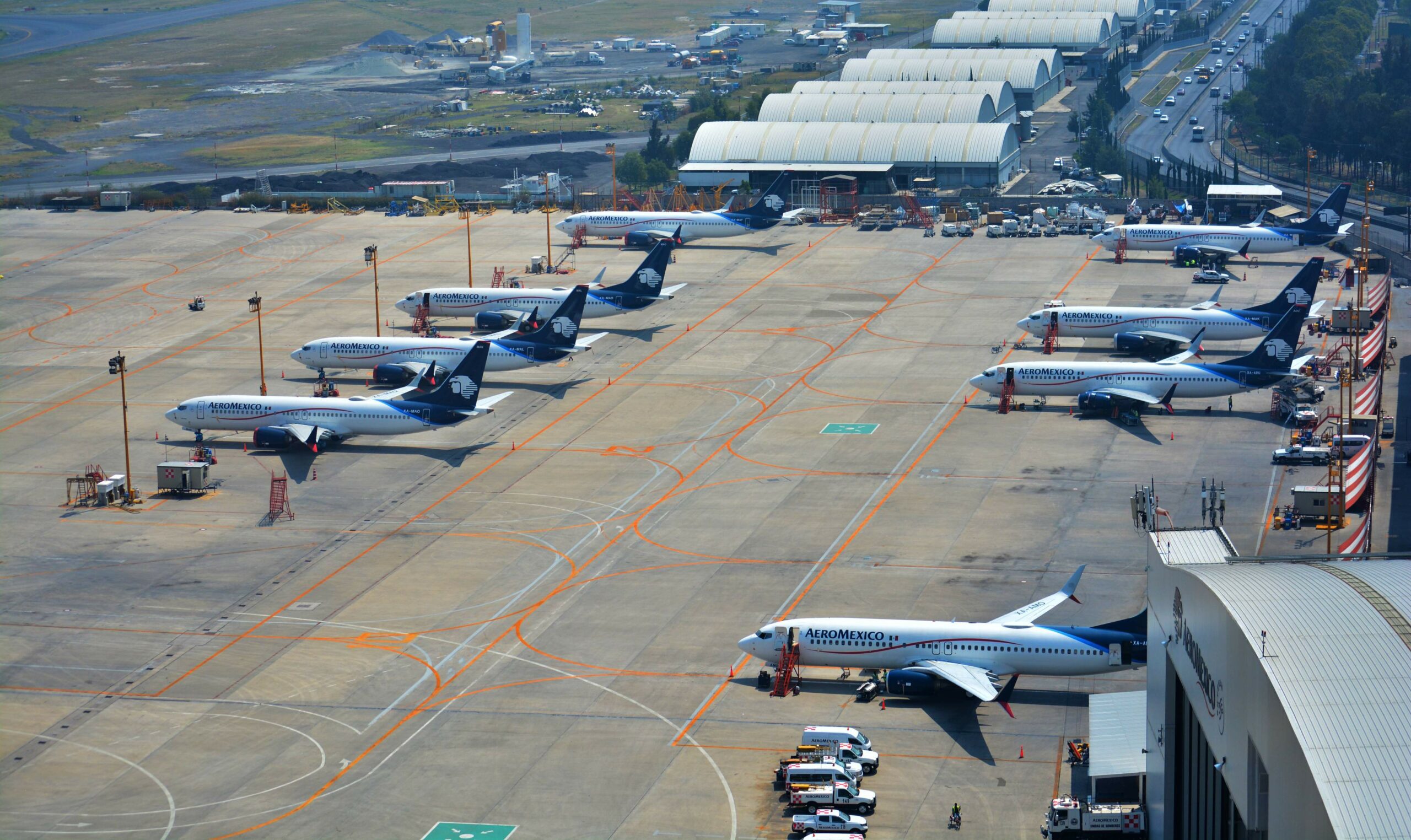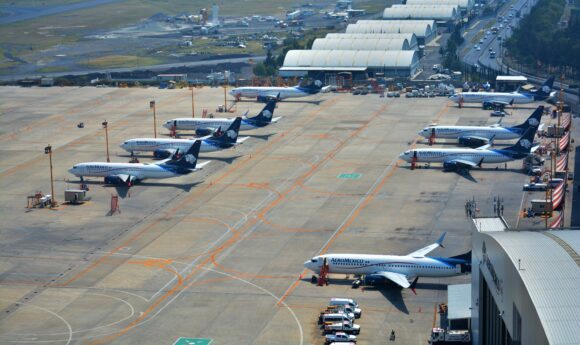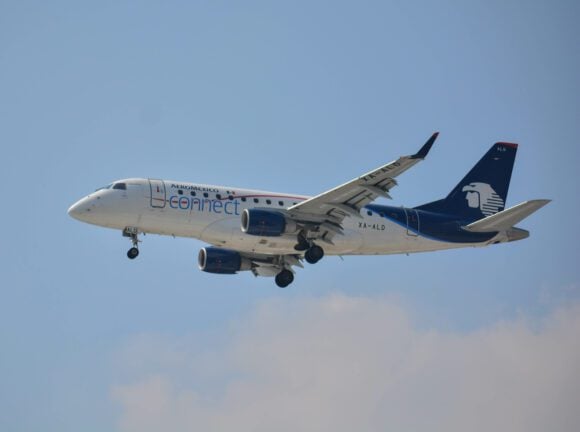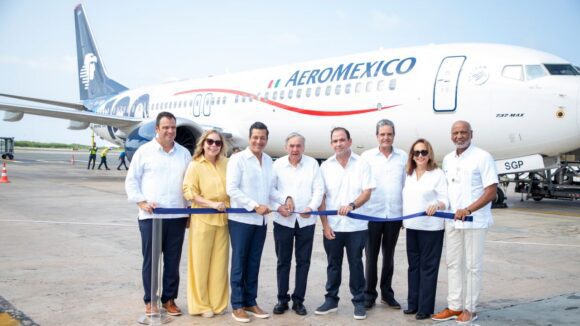
Aeromexico MAX scaled
Mexico’s commercial aviation sector reveals a system locked in a self-destructive spiral. While top-line passenger numbers suggest growth, a series of uncoordinated and politically motivated state interventions created a web of contradictions that has crippled the cargo market, distorted competition, and provoked a high-stakes diplomatic crisis with the United States. The government’s grand design is not building a stronger industry; it is systematically dismantling it from within.
At first glance, the Mexican commercial aviation market appears robust. Forecasts project a market value reaching as high as $16.80 billion by 2034, and domestic passenger volumes in the first half of 2025 climbed 4.5% over the previous year. But these macro figures mask a deep and troubling reality. Like a structurally compromised airframe painted with a fresh livery, the underlying integrity of the system is failing. A granular look at the operational data for 2025 reveals a system under immense stress, with key indicators pointing not toward sustainable growth, but toward policy-induced decay.
The source of this friction is not a market failure, but a series of deliberate state actions: the forced development of Felipe Ángeles International Airport (AIFA), the inauguration of a rival airport in Tulum (TQO), the relaunch of a state-owned airline, and the artificial strangulation of Mexico City’s primary airport (AICM). These policies, ostensibly designed to expand capacity and foster growth, are instead actively undermining one another, trapping the industry in a classic Catch-22.
A Market in Conflict: The Widening Gap Between Projections and Reality
The story of Mexican aviation in 2025 is one of two conflicting narratives. The bull case rests on solid fundamentals: a rising middle class, a resilient tourism sector, and the proven success of its domestic ultra-low-cost carriers (ULCCs). This momentum is real, reflected in the 30.73 million domestic passengers who flew in the first half of the year, a figure more than 20% above pre-pandemic levels.
However, the ground truth paints a much darker picture. This underlying growth is being eroded by new, powerful headwinds. ASUR, a major private airport operator, reported a 3.0% year-over-year decline in traffic across its Mexican airports in May 2025, driven by a concerning 5.6% drop in the high-value international passenger segment. This is not a sign of uniform strength; it is a signal that critical international corridors are weakening.
The most damning evidence of systemic disruption is found in air cargo, a direct barometer of economic activity. In the first five months of 2025, Mexico’s total air cargo volume fell by a sharp 6.3%. The international segment, the lifeblood of trade, plummeted by 7.6%. This is not a market slowdown; it is a policy-induced collapse. The epicenter of the damage is precisely where the government focused its efforts. Following the forced relocation of all cargo operations from the efficient hub at AICM to the new AIFA, cargo volume at AIFA itself collapsed by a staggering 16.9%. The decline at Toluca was even worse, at 18.9%. The data is unequivocal: the state’s intervention in the cargo market did not enhance it; it broke it.
The Broken Trust: How the FAA Downgrade Set the Stage for Today’s Crisis
To understand the severity of the current diplomatic crisis with the United States, one must look back to the period between May 2021 and September 2023. The U.S. Federal Aviation Administration’s (FAA) downgrade of Mexico’s safety rating to Category 2 was not merely a technical issue; it was a symptom of a deep institutional rot within Mexico’s aviation authority, the Agencia Federal de Aviación Civil (AFAC).
The downgrade, triggered by AFAC’s failure to meet ICAO safety standards, had immediate and devastating consequences. Mexican carriers were barred from launching new routes to the U.S., their most critical international market. The economic toll was immense: an estimated nine billion pesos ($450 million) in lost revenue and the forfeiture of 2.3 million potential passengers. Mexican airlines saw their share of the transborder market collapse from around 35% to just 17%.
The root cause was a chronic lack of resources and qualified personnel at AFAC. The agency’s own reports revealed that between January and June 2024, it failed to complete numerous safety verifications due to these shortages. The fact that it took 28 months to regain Category 1 status—compared to just four months for a previous downgrade—sent a clear signal to U.S. regulators: the problems in Mexico were structural and deep-seated.
This experience exhausted American patience and fundamentally reset the baseline of trust. So, when the Mexican government later took unilateral actions at AICM that violated its bilateral treaty obligations, the U.S. response was not another round of technical consultations. It was swift, punitive, and aimed at the heart of the U.S.-Mexico aviation relationship. Aside from the ideological differences within administrations, the trust deficit created during the downgrade saga is one of the main factors that led to the aggressive U.S. posture today.
Deconstructing the Grand Design: A Forensic Look at the State’s Initiatives
The current turbulence is the cumulative result of several large-scale, state-directed projects. Examined individually, their performance ranges from underperformance to outright failure, contributing collectively to the industry’s systemic risk.
The Two-Airport Problem: AIFA and the Cannibalization of AICM
Felipe Ángeles International Airport (AIFA) is the centerpiece of the government’s strategy. Inaugurated in March 2022, its stated purpose was to alleviate saturation at AICM. While AIFA projects it will handle 5.2 million passengers annually, its traffic is overwhelmingly domestic and engineered by state coercion, not organic demand. In the first four months of 2024, a mere 5.8% of its travelers were international.
The airport’s supposed profitability is an accounting fiction. While it reported a profit of MX 704 million in direct federal subsidies during the same period. AIFA is not a self-sustaining enterprise; it is a ward of the state.
To populate this airport, the government waged a campaign against AICM, decreeing a series of drastic reductions in hourly operations from 61 down to 44. This artificial constriction of supply at the market’s preferred airport was the direct trigger for the punitive U.S. response. This strategy did not create net value; it externalized the cost of AIFA’s existence onto the entire aviation ecosystem, resulting in a diplomatic crisis and a crippled national cargo market.
The Riviera Maya Rivalry: Tulum’s Zero-Sum Game
In December 2023, the government opened another major project, Tulum International Airport (TQO). After an initial boom, the airport is now experiencing a significant market correction, with major international carriers like United Airlines, American Airlines, Discover Airlines, and Copa Airlines withdrawing services.
The reason is clear: TQO is not primarily creating new demand but is cannibalizing traffic from the established and highly efficient hub at Cancún International Airport (CUN). The airports are too close, serving the same catchment area. In October 2024, as TQO ramped up, traffic at CUN plummeted 14.9%.
The government, instead of expanding the world-class CUN hub, chose to build a competitor next door. The result is two major airports operating below their potential, with duplicated infrastructure and disrupted airline networks. An American Airlines executive confirmed the core problem: “the whole industry going in there at the same time was too much capacity to absorb at once.”
The Ghost in the Machine: Mexicana de Aviación
The relaunch of the state-owned Mexicana de Aviación in December 2023, operated by the Ministry of Defense, was framed as a pro-competitive move. Nearly 18 months later, it is a commercially irrelevant, market-distorting entity.
Mexicana holds less than 1% of the domestic market. In the first half of 2025, it carried a mere 180,000 passengers, a rounding error compared to the 11 million-plus flown by each of the market leaders. Its seat occupancy rates hover between 30% and 48%—a catastrophic figure in an industry that requires an 85% average to be viable.
Kept alive by opaque state subsidies, Mexicana operates as an irrational competitor. It forces efficient private airlines to compete against a state-funded entity that does not need to turn a profit. This creates artificial price pressure and degrades the financial health of the very carriers that form the backbone of the industry. It is a cash-incinerating vanity project, a ghost in the machine that serves no productive economic purpose.
The Cascade Effect: How Domestic Policy Ignited a Transborder Fire
The most damaging consequence of these domestic policies is the severe regulatory crisis they created with the United States. The link is direct and causal. In a series of blunt orders, the U.S. Department of Transportation (DOT) tentatively proposed to withdraw the grant of antitrust immunity (ATI)—the critical legal shield that allows airlines to function as a single entity on international routes—from the Delta-Aeroméxico joint venture.
The DOT’s rationale is not about the JV’s performance; it is a direct punishment for the Mexican government’s actions, which it considers a “blatant disregard” of the U.S.-Mexico Air Transport Agreement. The DOT explicitly cites the capacity reductions at AICM and the forced relocation of cargo operations as treaty violations. The U.S. government views these moves not as legitimate operational measures, but as anti-competitive protectionism for AIFA.
The termination of the JV, tentatively set for October 26, 2025, would be calamitous. Delta and Aeroméxico warn it could lead to the cancellation of two dozen routes and an immediate economic impact of $800 million. It represents a profound strategic failure: in its quest to prop up a domestic infrastructure project, the Mexican government sacrificed its own flag carrier’s most critical international partnership. Aeroméxico is now collateral damage in a policy war it did not start.
This crisis has also frozen the approval of another pro-competitive alliance: the proposed joint venture between Viva Aerobus and U.S.-based Allegiant Air. A venture designed to introduce dozens of new low-cost routes is being held hostage by the same diplomatic dispute.
The Incumbents Under Siege
Mexico’s private airlines are now navigating a minefield.
- Volaris and Viva Aerobus, the ULCCs that control a combined 73% of the domestic market, face intense pressure. Both reported declining revenues in the second quarter of 2025. They are battling the irrational pricing of the subsidized Mexicana, operational limits at AICM, and the global Pratt & Whitney engine crisis that has grounded parts of their fleets. Their strategy is a retreat to core principles: ruthless cost discipline and a focus on high-margin ancillary revenues.
- Aeroméxico, the nation’s sole full-service carrier, is caught in the crossfire. Its domestic market share has eroded to 25% as it pivoted toward the now-threatened international market. The potential dissolution of its Delta JV is an existential threat not of its own making. The airline’s future now depends less on its corporate strategy and more on a diplomatic resolution to a conflict created entirely by its own government. And, not without a sense of irony, if the Delta-Aeroméxico JV is set to fail, the most obvious move for the mexican carrier would be to redirect its efforts to solidify its domestic network, hurting Mexicana’s already slim chances of competitiveness even further.
The evidence is definitive: the Mexican government’s uncoordinated, state-first approach to aviation has created a system where policies reciprocally damage one another.
- The policy to boost AIFA triggered the crisis that threatens the Delta-Aeroméxico JV.
- The policy to make AIFA a cargo hub shrank the entire national cargo market.
- The policy to launch Mexicana undermines the financial health of the private carriers that actually comprise the market.
- The policy to open Tulum fragmented the market and cannibalized the successful Cancún hub.
It is a stark reality playing out in real-time. The pursuit of disparate political projects in a strategic vacuum has distorted the market, destroyed value, and pushed the entire sector into a state of heightened risk. Despite its fundamental strengths, Mexican aviation is in a precarious position, weakened not by market forces, but by the very policies designed to promote it.
Views: 351



